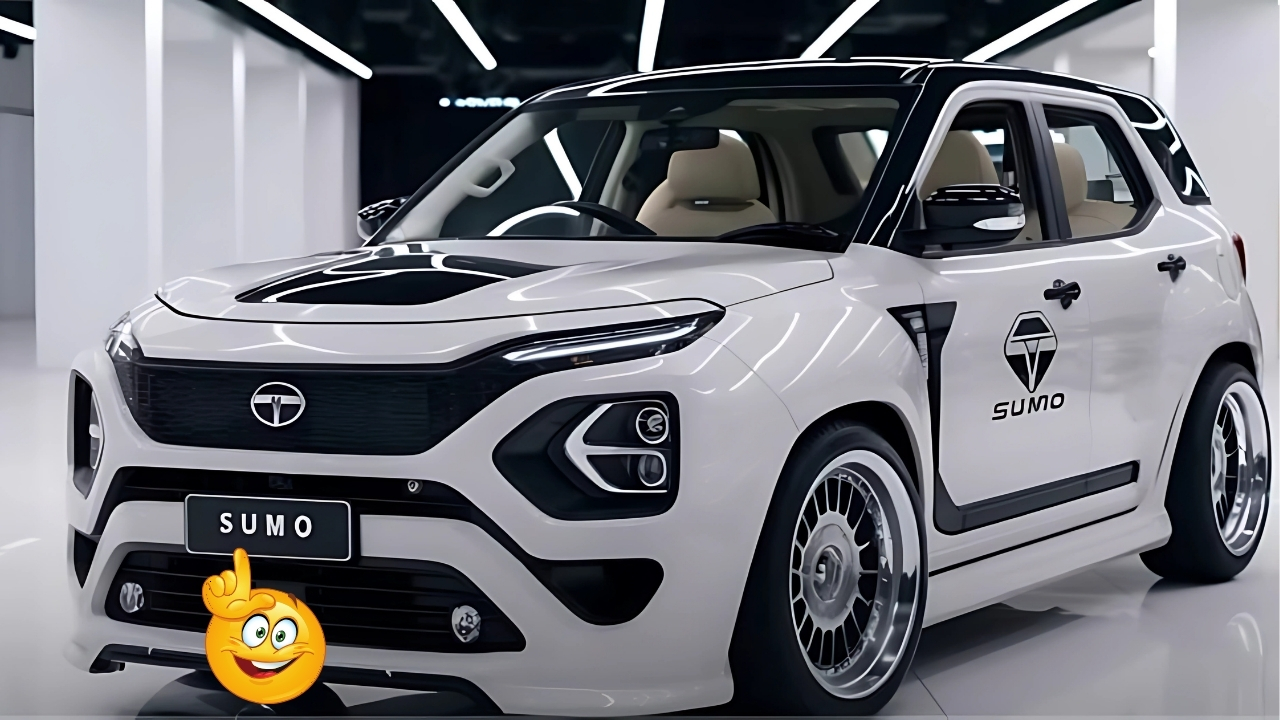Tata Sumo: The genesis of the Tata Sumo reflects a distinctly Indian approach to automotive development.
In the early 1990s, India’s liberalizing economy created both opportunity and challenge for domestic manufacturers previously sheltered by protectionist policies.
Tata Motors (then Tata Engineering and Locomotive Company) recognized the emerging need for a robust multi-utility vehicle that could bridge the gap between agricultural workhorses like the Mahindra Jeep and prohibitively expensive imported alternatives.
The Sumo emerged from this context in 1994, named as a tribute to Sumant Moolgaokar, a pioneering figure in Tata’s development.
Its design philosophy prioritized practicality over pretension—a boxy, upright structure that maximized interior volume within a manageable footprint, underpinned by rugged mechanicals capable of withstanding India’s punishing road conditions.
Initial variants featured a 1948cc naturally aspirated diesel engine producing a modest 68 horsepower—figures that appear unimpressive on paper but proved adequate given the vehicle’s intended usage patterns.
More significant than outright performance was the engine’s unfussy nature, willingness to run on variable quality fuel, and capacity for straightforward roadside repairs—attributes perfectly aligned with operational realities in its primary markets.
Tata Sumo: Design- Function Defining Form
The Sumo’s aesthetic emerged directly from its purpose rather than stylistic fashion. The slab-sided body with minimal contours facilitated both manufacturing simplicity and interior space efficiency.
Large glass areas provided excellent visibility—a critical consideration for navigating crowded urban environments and treacherous mountain roads alike.
The high seating position afforded drivers commanding road presence, while the tall roof accommodated passengers of varying statures with traditional headwear.
Over its lengthy production run, the exterior design saw modest evolutionary changes rather than revolutionary revisions.
The first significant update arrived with the Sumo Victa in 2004, which softened some of the original’s utilitarian edges with more contemporary headlamps, revised grille treatment, and improved interior appointments.
The Sumo Grande, introduced in 2008, represented the most substantial redesign, incorporating more modern styling elements while maintaining the fundamental space-efficient architecture.
Throughout these iterations, certain design constants remained—the squared-off wheel arches, the nearly vertical windshield, the pragmatic approach to details like external door hinges, and the side-hinged rear door with mounted spare tire.
These elements weren’t merely stylistic choices but reflected the vehicle’s working-class roots and expected usage patterns.
Interior: Pragmatic Spaciousness
Step inside any generation of Sumo, and the design priority becomes immediately apparent: maximum usable space from minimum external dimensions.
The cabin architecture employed a thoroughly vertical approach, with an upright dashboard, flat door panels, and bench seating that prioritized capacity over contour.
This space efficiency enabled configurations ranging from standard seven-seater arrangements to ten-seater variants frequently employed in rural taxi services.
Materials selection reflected expected usage patterns rather than luxury aspirations. Hard-wearing fabrics, durable plastics, and easily cleaned surfaces predominated—choices that sacrificed tactile pleasure for practical longevity.
Controls and instruments followed similar pragmatism, with large, clearly labeled switches and dials that could be operated while wearing work gloves or navigating rough terrain.
As production evolved, creature comforts gradually expanded to include air conditioning, power steering, and improved sound insulation—concessions to changing market expectations without compromising the fundamental utilitarian character.
However, even later variants maintained a function-first approach that distinguished the Sumo from increasingly lifestyle-oriented competitors.
Mechanical Evolution: Durability Above All
The Sumo’s mechanical architecture underwent progressive refinement while maintaining its core identity as a rugged, serviceable vehicle built for longevity under challenging conditions.
The original’s naturally aspirated diesel engine gave way to more powerful turbocharged variants, culminating in the 3.0-liter CR4 common-rail diesel producing 85 horsepower and 250 Nm of torque in later models.
Transmission options remained deliberately straightforward, with 5-speed manual gearboxes featuring ratios selected for tractability rather than outright performance.
The heavy-duty clutch, while requiring substantial pedal effort, provided durability under the frequent stop-start conditions of Indian traffic and when navigating steep gradients with full passenger loads.
The suspension system embodied similar pragmatism—independent front suspension with torsion bars coupled with leaf-sprung rigid rear axles in most variants.
This configuration prioritized load-carrying capacity and repairability over ride refinement, a trade-off willingly accepted by its target users.
The substantial ground clearance—typically exceeding 180mm—proved essential for navigating both urban obstacles like unmarked speed bumps and rural challenges including unpaved roads during monsoon seasons.
Perhaps most significant was the fundamental robustness engineered into all mechanical systems.
Components were typically overbuilt, with substantial safety margins that allowed for operation beyond recommended parameters when circumstances demanded—a not-infrequent occurrence in its working life.
This intrinsic toughness contributed significantly to the model’s legendary reliability reputation, particularly in areas with limited service infrastructure.
Cultural Impact: Beyond Transportation
The Sumo’s significance extends far beyond its mechanical attributes to encompass its role in India’s social and economic landscape.
In rural areas, Sumo ownership often represented the first motorized transportation for extended families, enabling access to educational institutions, healthcare facilities, and employment opportunities previously beyond practical reach.
The vehicle’s capacity to carry both passengers and goods simultaneously proved particularly valuable in agricultural communities, where it served dual roles as family transport and produce delivery vehicle.
In the tourism industry, particularly in mountainous regions like Himachal Pradesh, Uttarakhand, and Ladakh, the Sumo became the default choice for tour operators—its combination of passenger capacity, luggage accommodation, and all-terrain capability proving ideally suited to the varied demands of this application.
The sight of Sumos negotiating hairpin bends on precipitous mountain roads, often loaded well beyond recommended capacity, became an iconic image of Indian tourism.
Perhaps most visibly, the Sumo established itself as the backbone of shared transportation systems in smaller towns and rural areas.
Operating as local taxis, these vehicles typically followed semi-fixed routes, collecting and depositing passengers along the way with fares negotiated through established local conventions rather than meters.
This informal transit system provided essential mobility in areas underserved by formal public transportation, creating economic opportunities for drivers while connecting communities.
The Sumo also found favor with institutional users including the military, police forces, and government departments operating in challenging environments.
The vehicle’s combination of passenger capacity, cargo flexibility, and terrain capability made it particularly suitable for patrolling border areas, conducting rural healthcare outreach, and supporting administrative functions in remote regions.
Market Legacy and Discontinuation
By the standards of typical automotive product cycles, the Sumo’s production run was extraordinary—spanning 25 years with only evolutionary changes rather than complete redesigns.
This longevity reflected both the fundamental soundness of the original concept and Tata’s recognition of the vehicle’s continued relevance despite changing market fashions.
However, the model’s eventual discontinuation in 2019 became inevitable as regulatory requirements advanced beyond the platform’s capacity for adaptation.
The implementation of stricter safety norms including mandatory airbags, ABS, and crash test requirements, combined with progressively stringent emission standards, presented technical challenges incompatible with the Sumo’s aging architecture.
Equally significant were shifting market preferences, as customers increasingly prioritized car-like refinement, contemporary styling, and feature content even in utilitarian segments.
The emergence of more modern competitors including Tata’s own Sumo Grande and subsequent models like the Safari Storme and Hexa catered to these evolving expectations while compromising some of the original Sumo’s fundamental practicality and repairability.
Enduring Legacy and Future Potential
Despite its formal discontinuation, the Sumo’s influence persists both in the hundreds of thousands of examples still providing daily service across India and in the vehicle design approaches it pioneered.
The model established that indigenous manufacturers could create uniquely Indian solutions for domestic transportation needs rather than merely adapting international designs.
The principles embodied in the Sumo—space efficiency, mechanical robustness, serviceability, and adaptability to varied operating conditions—remain relevant design criteria for vehicles intended for similar applications.
The model’s legacy continues in Tata’s current product development philosophy, which maintains a pragmatic approach to creating vehicles suited to actual usage patterns rather than marketing-driven aspirational positioning.
Industry observers speculate about potential for a spiritually-successor vehicle incorporating the Sumo’s core virtues within a contemporary technical framework.
Such a product would require careful balancing of regulatory compliance, modern customer expectations, and the fundamental practicality that defined the original.
Whether market conditions would support such a vehicle remains uncertain, particularly as India’s automotive landscape increasingly fragments between urban lifestyle-oriented products and specialized commercial applications.
Tata Sumo : An Authentic Indian Automotive Icon
The Tata Sumo earned its place in India’s automotive pantheon not through marketing-constructed mythology but through genuine utility demonstrated across millions of kilometers in the most demanding conditions.
Its significance transcends typical product evaluation metrics to encompass its role in India’s socioeconomic development—connecting communities, creating livelihoods, and demonstrating indigenous manufacturing capability.
While contemporary vehicles may exceed the Sumo in specific performance metrics, technological sophistication, or refinement, few can match its perfect alignment with the actual transportation needs of much of India.
The model’s quarter-century production run stands as testament to the enduring value of purpose-driven design that prioritizes functional requirements over passing trends.
As India’s automotive industry continues its rapid evolution toward electrification, connectivity, and autonomous capabilities, the Sumo’s legacy offers a valuable reminder: genuine transportation solutions emerge from deep understanding of user requirements rather than technology for its own sake.
This lesson may prove increasingly relevant as manufacturers navigate the tension between technological possibility and everyday utility in developing markets where practical mobility remains the primary automotive purpose.
The squared silhouette of the Tata Sumo may have disappeared from production lines, but its imprint on India’s roads, communities, and automotive design philosophy endures—a lasting tribute to thoughtful engineering directed toward authentic human needs.



